This list presents the graves of ten soldiers who made remarkable contributions to the founding of the United States and who have a headstone or memorial that is unique in its design. Each of the tombs or graves on the list are in the eastern United States. After George Washington, this list is not in any particular order.
A noted significant patriot, Benedict Arnold, is not included because he switched sides. It would have been interesting to include Arnold’s grave, as it is in a church in England. The Marquis de Lafayette’s grave in France was also excluded because of its overseas location.
General George Washington, Mt. Vernon, Virginia
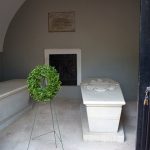
One cannot exclude the obvious top choice for most people. Washington’s grave is somewhat unique in that it is located on his own property at Mount Vernon and that he was removed from a smaller temporary crypt on the same property to a more permanent location in a crypt made of brick. Washington was worshipful master of a masonic lodge in Alexandria for a number of years, which is why a masonic memorial to Washington, some ten stories tall, stands there. There is a misunderstanding that only Masons are allowed inside the Washington crypt when the iron gates are opened each year on the date of his death, December 14; in fact, whichever organization lays a wreath is allowed inside, including military veterans and leaders of groups such as the Daughters of the American Revolution and the Sons of the American Revolution.
Major General Nathanael Greene, Georgia
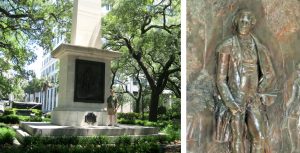
Washington was devastated to learn of the untimely death of his most trusted general, Nathanael Greene, who died at the young age of forty-three in 1786 at his Mulberry Grove plantation outside of Savannah. For over a century his remains were interred at the Graham Vault in Colonial Park Cemetery in Savannah. On November 14, 1902, through the efforts of Rhode Island Society of the Cincinnati President Asa Bird Gardiner, he was reinterred in downtown Savannah at Johnson Square, under an impressive, handsome obelisk that includes a high-relief sculptured likeness of the general.
Crypt of Major General Jabez Huntington and his sons, Brevet Major General Jedediah Huntington and Brigadier General Ebenezer Huntington, Connecticut

Located in the Old Burying Ground in the Norwichtown section of Norwich, this may very likely be the only grave in the entire U.S. where not one or two but actually threeRevolutionary War-era generals are buried. Jabez was a militia general in charge of the entire eastern Connecticut militia, and hosted Generals Washington and Gates at his house in Norwich for a conference on April 8, 1776. Because he was a wealthy merchant, his son-in-law, John Trumbull, painted his first full-length portrait in 1776 or 1777, which is on permanent view at the Connecticut State Museum. Sons Jedediah and Ebenezer Huntington served throughout the entire war, from 1775 to 1783, and were both original members of the early sixteen signers of the Society of the Cincinnati Institution created in May 1783. Ebenezer went on to be commissioned by President John Adams as a brigadier general in the Quasi-War with France in 1798. He later served two terms as a Federalist U.S. Congressman, alongside Culper Spy Ring case officer, Lt. Col. Benjamin Tallmadge. A third son, Joshua, Huntington was a major then colonel in the militia who served in the siege of Boston in 1776 and the Battle of New York. He then served as agent for the naval board for U.S. Congress in supervising the nearby construction of the U.S. Navy frigate Confederacyin 1777-78, which was named for the Articles of Confederation.
Joseph Plumb Martin, Maine
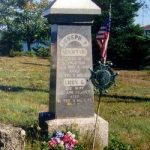
Most readers of Journal of the American Revolution are very familiar with the exploits and published memoirs of the humble private, later corporal, from Connecticut and then Maine, Joseph Plumb Martin. He lived until he was eighty-nine, and luckily was among the very few Revolutionary War patriots who were photographed. Rarer still is that his wife was still alive and photographed with him. Joseph died in 1850 in Stockton Springs, Maine, and is interred with his wife at Sandy Point Cemetery in Waldo County, Maine. This cemetery provides a view of the Penobscot River and distant Atlantic Ocean off on the horizon.
Captain John Paul Jones, Annapolis
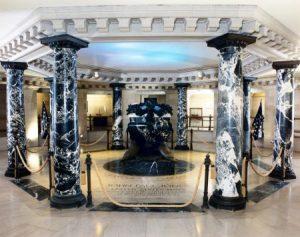
This grave of the legendary, arguably co-founder of the U.S. Navy, is the most ornate. Captain Jones’s grave is located in the crypt of the chapel of the U.S. Naval Academy in Annapolis, Maryland. His remains had been buried where he died in France in 1792, but were reinterred in Annapolis in a 1906 a ceremony presided over by President Theodore Roosevelt. I first visited this grave as a child with my parents because my mother was once a U.S. Navy nurse.
Major General David Wooster, Connecticut
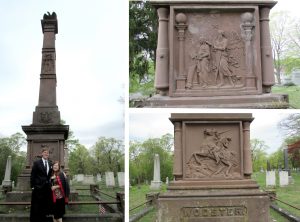
General Wooster was mortally wounded while riding his horse in fighting the British raid on the military stores at Danbury, commonly referred to as the Battle of Ridgefield. The battle occurred on April 28, 1777, and Wooster lingered in his deathbed until he passed away on May 2. At age sixty-six, Wooster was the oldest general to die in service during the Revolution. Wooster was a founding member of the Hiram Lodge Number One in New Haven, and it is for that reason that members of the Lodge erected a thirty-foot-tall obelisk-style monument to him in the mid-nineteenth century. It is covered in Masonic symbolism and is one of the most artistic, intricate monuments to a Revolutionary War patriot one can encounter.
Major General Israel Putnam, Connecticut

So popular was his original gravesite that tourists from all over chipped off pieces of his original headstone as souvenirs. As a result, a group congregated in the late nineteenth century, raised money and had a figure of Israel atop a horse sculpted and erected as a mammoth monument over his grave. This is located in rural Brooklyn, Connecticut, a small town that was once part of Putnam (yes, named after the general, their most famous resident ever). It is easy to access since “Ol’ Put” peers over the local highway in the center of town.
Major General Alexander Hamilton, New York
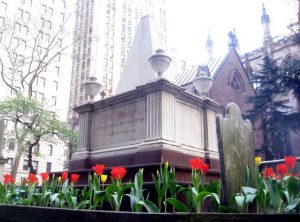
Hamilton served as one of Washington’s most-trusted, important aides-de-camp between 1777 and 1781. Hamilton also finally had the field command he begged for, which resulted in his leading the nighttime assault by light infantry on the Yorktown Redoubt Number 10. Hamilton’s funeral was impressive following the controversial death by duel at the hands of Vice President Aaron Burr. The funeral included members of the Society of the Cincinnati in New York as well as the St. Andrews Society that paid homage to members’ Scottish ancestry. He very appropriately was laid to rest in the churchyard of Trinity Church, overlooking Wall Street’s western edge from the northern section of the churchyard. The grave was recently restored and cleaned over a year-long project as a result of the popularity of Hamilton thanks largely to the musical Hamilton. It is worth noting that a simple flat stone marking the grave of Maj. Gen. William Alexander, aka Lord Stirling, is tucked behind the church only a few hundred feet away, sadly largely forgotten. Thanks to the efforts of myself and a dear friend, John Resto, several U.S. flags were planted at the grave to help the public find him since even the docents at the church are unaware of his important contributions to the Revolution or the exact location of his grave.
Brigadier General Richard Montgomery, New York

This rather young general died during his ill-fated attack on Quebec City in a winter storm. This was the same nighttime attack in which Benedict Arnold and the then-obscure Maj. Daniel Morgan were wounded. The idea of attacking Canada was largely the brainchild of Benjamin Franklin, who felt so guilty about Montgomery’s death that he convinced Congress to commission the first-ever memorial to a fallen U.S. general. Franklin hired French sculptor Jean Jacques Caffieri. Montgomery’s remains were relocated to New York in 1818. Almost as impressive in its intricate design and use of marble and other expensive materials as the grave of John Paul Jones, Montgomery’s might be the only memorial/grave inside a church (St. Paul’s, New York City) yet also viewable from driving in a car, since it is built into the wall of the church.
Major General John Sullivan, New Hampshire

This general and his grave are notable for the confusion as to the whereabouts of his remains. One might assume they are in front of his house—a beautiful home that was for sale only about five years ago. It is unclear how many viewers of the property liked (or were spooked by) what is thought to be the grave of the famous patriot prominently marked with a vertical memorial in the front yard of this house. Not only was he governor of New Hampshire, but he was also a prominent Mason. The surprising fact is, however, his remains are at another location, marked by a weeping willow headstone at the nearby Sullivan family cemetery.
Honorable Mentions:
Pierre L’Enfant, Virginia
Famous architect Pierre L’Enfant, also a military engineer, is buried at the Arlington National Cemetery in front of Arlington House, which was famously the home of Robert E. Lee. He was originally buried at the Green Hill Farm in Maryland. The marker is a prominent table stone grave with a panoramic view of Washington D.C. This monument was created in 1911 and was dedicated in a ceremony led by President William. Howard Taft. Engraved on the monument is a portion of L’Enfant’s own plan of a diagramed map of the capital city which he designed.
Doctor Joseph Warren, Massachusetts
Dr. Warren, famous as a leader of the Boston Sons of Liberty, was killed at the age of thirty-four at the Battle of Bunker Hill. His grave is located at Forest Hills Cemetery in Jamaica Plain outside of Boston. In addition to his vertical headstone, leaning against a large rock, is a life-sized bronze statue of Warren commissioned by the masonic grand lodge of Massachusetts.
Strangest Civilian Patriot Grave: John Jay, New York
There is only one Founding Father whose grave is not open to the public: John Jay. The grave of Jay is inside the Jay family cemetery on the property of the Jay Estate in Rye, New York. The cemetery is located in the woods. It is unclear why the Jay family chose to make the cemetery private; perhaps a reader might know the answer?






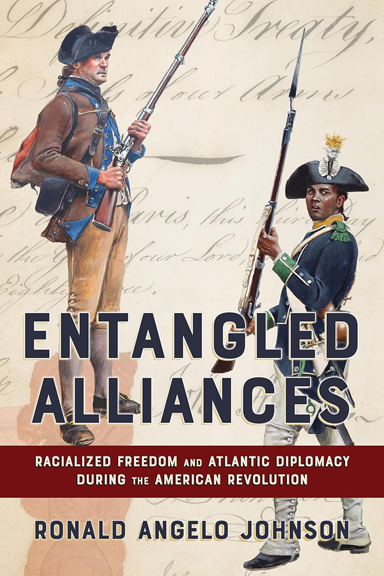

37 Comments
Definitely a solid list! You mention Benedict Arnold was omitted because he switched sides and is buried in England. There is a monument, however, to the “good” part of Arnold – his leg, wounded at the Battle of Saratoga – memorialized by the “boot monument” located on the battlefield.
Thank you, Derrick! Yes, plus there is an empty niche for Arnold at the Battle of Saratoga monument in Victory village. https://en.m.wikipedia.org/wiki/Saratoga_Battle_Monument
Great article enhanced by great photos. I would have liked to see Margaret Corbin as part of this list. Her grave at West Point, is currently under examination. During renovation of the cemetery, her grave was damaged. They used this as an opportunity to examine the remains. It turns out that the wrong remains were interred, and they are currently searching to find the correct remains.
Arnold and his wife are buried in the basement of St. Mary’s Battersea church ⛪️ n London. The area the graves are located in are used as a preschool.
How about an article of the burials of the “common man” not the generals who sent many unprepared into battle? That is: Battle of Long Island, etc. Really like your articles on this site! Hurrah!
Thank you, Carl. On this date Sergeant Daniel Bissell is Connecticut, who would later receive the Badge of Military Merit, became a spy for Washington while behind enemy lines in occupied New York City. His grave is upstate NY is special in that there are two stone markers plus a fleet of smaller metal markers from the SAR, DAR and other groups. https://www.google.com/amp/s/todayincthistory.com/2019/08/13/august-13-daniel-bissell-becomes-a-spy-for-the-continental-army/amp/
Jeremiah O’Brien’s grave site in the O’Brien family cemetery in Machias, Maine. On 12 June 1775, under the command Commander Jeremiah O’Brien and with a band of Machias, Maine Patriots, armed with a variety guns, primitive weapons and their ship Unity, they pursued and captured Great Britain’s armed schooner, the HMS Margaretta in the first Naval Battle of the American Revolution. https://sandsquiggles.com/2011/10/22/history-in-machias-maine/ Click on my Blog with the previous URL for comments and photos of the O’Brien Cemetery.
I agree completely. It is great to honor the leaders of the revolution. But, in my view, if the have a large monument it stands to reason people will remember their stories. Info on the unsung would be a fascinating article, including where they ended up post war. For example, in Athens, Alabama, there is a veteran from the battle of King’s Mountain buried in the old city cemetery. It very interesting to know what led him to rural Alabama.
Wonderful insights and research. I agree some non general gravesites would be interesting. How about West Point deaths as the Army was disbanding. I think there were many.
With concern I observe many of these Historic Monuments are in dire need of remedial conservation services. All here can share their own recollections of countless other monuments and markers in need of various levels of conservation service intervention. The Legacy Marker Program is ready to engage your youth and communities at large in conducting this important and valuable service.
Respectfully,
Eugene Hough
Philadelphia Light Horse 1774 #2260
Legacy Marker Program
A significant memorial: The gravestone of Caesar Drake (1702-1806) the freed former slave of Nathaniel Drake, whose home was Washington’s HQ on June 26, 1777. Caesar was a member of Capt. Davidson’s Team Brigade hauling supplies for the army. A respected church member, his original stone is at the Scotch Plains Baptist Church https://www.findagrave.com/memorial/28248375/caesar-drake. I have a photo of the broken original if you want it.
Great idea for an article. Nice history and fantastic pictures. More please. How about some of the “foreigners” like Von Steuben, Pulaski, Lafayette and Koszciusko? Of course you’ll have to go to Poland and France.Tough assignment!
General Richard Montgomery may yet take his revenge on the British in a roundabout way. There is a Liberty ship called Richard Montgomery sunk in the Thames estuary In 1944 in the U.K., filled with munitions which could still go off, producing a tidal wave….
John Jay information
https://www.findagrave.com/memorial/543/john-jay
Enjoyed this article! Thanks.
Outstanding tribute…..enjoyed the history and memorable sites…well done and thanks
Very nice article. Many of our colleagues are aware of my project to document and photograph the grave sites of every general in the RW which number about 273. This figure includes both militia and Continental who held their rank between Lexington/Concord to NY Evacuation Day. Altogether I have about 110 completed. Obviously I cannot get all of these officers myself so I have received assistance from many of our colleagues and even foreign governments. I noticed that you just posted several sites I do not have (Covid is preventing me from traveling) and was wondering if you would like to join our gang? I can be reached at An*********************@gm***.com
All the best
Hello Andy,
I met a guy at Monmouth Battlefield who is doing the same thing. We started to talk about this as I am one who liked to photograph rev war veterans and spoke about the different generals we have photographed. I have to look for his name and maybe he is someone that is part of your group. He didn’t have Lord Stirling which was one that I did have. I am always looking for cemeteries with Rev war veterans.
John Resto
One more entry, that of the “Martyrs of the Prison Ships” in Ft Greene Park would have brought your total to 11,510. Impressive monument by McKim, Mead and White to those who died on board the HMS Jersey and other similar prisons, and whose bodies were thrown overboard to be washed up on shore and buried by local patriots, who knew the price these heroes had paid. Later they were reinterred at the present site to rest forever in a more appropriate tribute.
Thank you for that. What those gentlemen went through 🙁 for us 🙂
Excellent suggestion, Bob. I will be sure to include that huge, very important memorial in a future feature – a sequel on soldiers’ graves and monuments.
Loved this beautiful tribute!
In Montgomery Co. PA there are obviously many graves of patriots including General Nash in Towamencin which is being swallowed up by highways, but it is saved by the little Towamencin Mennonite Church where his tall marker stands along with other soldiers. It’s right on 40 Foot Rd @ Sumneytown Pike. I believe Nash was brought back badly wounded from the Battle of Germantown and succumbed to his injury there – GW presided at his funeral service. It is a jewel of an area for our history. Nearby is Pennypacker Mills with many other graves of infantry and officers.
A local elementary school has Nash’s namesake, my hubs’ boy scout troop from the 1970s, and of course there’s Nashville, TN from the area in which the General hailed.
The Steuben Memorial State Historic Park is in a quiet farm setting in upstate New York, and the baron’s grave is a stone memorial under some trees in the back of the house. The grave of Mary Hays McCauley (Molly Pitcher of Monmouth Battle fame) in downtown Carlisle, PA is a very small stone, with only her initials, but close by within the cemetery is an impressive statue and memorial to her.
Great article! Where can I find the photograph you mention of Joseph Plumb Martin? I can find a portrait painting of him and his wife on Wikipedia, but nothing about a photograph. Thanks for some direction!
A photograph alleged to be of Joseph Plumb Martin and a woman (his wife?) is posted with his entry on the FindAGrave web site, https://www.findagrave.com/memorial/8619/joseph-plumb-martin
This photo was submitted to JAR for publication a few years ago, but the provenance was not sufficiently clear to allow us to publish it; the submitter said that it was Martin, but the photo itself (to our understanding) has no clear identification of the sitters.
Hi Don,
Has the photo of Martin been shown to Maureen Taylor? I had a photo of an ancestor who served in the Revolution, I sent it to Maureen and she was able to declare with evidence that the photo was not my ancestor. I was hoping for a chance that my ancestor would be included in one of Maureen’s “Last Muster” books.
Thank you,
Brian
Yes, we did check with her.
And of course the Signer from Suffolk County, Long Island, Gen. William Floyd, buried in the Westernville Presbyterian Church Cemetery, Westernville, NY.
There is actually much more to the story of Nathanael Greene’s original grave. For his first century of internment, Greene shared space with the very gallant, Colonel John Maitland of the 71st Highlanders.
After having saved the garrison at Savannah and defeated the combined French and Patriot armies, John Maitland fell ill. Some said alcohol played a role but that seems like sour grapes when discussing a man as courageous and highly thought of as Maitland. Even the Patriot Press credited the British victory to his “presence, skill, and activity.” But he died a few days later from fever contracted in the South Carolina swamps, and. . .
Interestingly enough, Colonel Maitland was interred in a vault owned by one John Graham in Savannah. Several years later, Nathanael Greene was literally buried in the same vault, and then forgotten. About 120 years later, in 1901, folks started looking for Greene and opened the vault, where they found him safely interred. They didn’t mention the second body.
But, after another 80 years passed, in 1981 – a search was made for Col. Maitland. Again the vault was opened and a body identified. This time it was John Maitland, identified by the missing arm he lost in the Seven Years War so long ago.
He was returned to Scotland for reinterment at the St Marys Church in Haddington where many of his ancestors are also buried. Sort of interesting, other than John Andre’, I believe Maitland is the only British officer whose body was returned to England. It was the British tradition to bury their soldiers where they fell.
There is an annual celebration at the tomb of General Glover (who supplied the boats for Washington’s crossing of the Delaware) in Old Burial Hill Cemetery, Marblehead. see the Wikipedia article on him.
Here is a pretty good list of Revolutionary War veteran graves, along with coordinates and photos
https://www.waymarking.com/cat/details.aspx?f=1&guid=93072f66-30ff-4165-9854-50ccb9060eab
Great article and discussion. I had the pleasure of ordering a marker from the VA for an ancestor. Its now in storage in Oak Hill WV at the funeral home and awaiting an SAR ceremony. It was an interesting process with great assistance from the VA.
Major General Seth Pomeroy was 70 when he died in the line of duty in 1777: https://www.findagrave.com/memorial/9605466/seth-pomeroy
Remarkable and fascinating article – could serve as the basis for a compelling guidebook.
On the subject of non-soldiers who played a key role off the battlefield, I would mention Haym Salomon, the Jewish financier who provided enormous assistance to the cash-strapped forces of liberty. He is buried in the Mikveh Israel cemetery in Philadelphia: https://www.findagrave.com/memorial/9559289/haym-s_-salomon
Dear Mr. Cregeau: I have not researched this personally, but was told many times by Richard K. Showman, the first editor of the Nathanael Greene Papers, that Greene’s body was washed up in a flood and that money was raised in Rhode Island to return his body to his home state and re-inter it with a suitable monument. When the delegation from Rhode Island arrived in Georgia, they found Greene had been buried in Johnson Square with a grand obelisk marking the spot. The delegation returned to RI satisfied that Greene had been properly honored and the money raised was placed in a bank where it sat until 1971 when Albert T. Klyberg, the Director of the RI Historical Society, convinced members of the Nathanael Greene Memorial Association that a printed edition of Greene’s Papers would be a fitting monument to Greene and the funds were and used as seed money to finance the Papers of General Nathanael Greene Papers project, which by its completion in 2005 published thirteen volumes of Greene’s papers.
Richard Montgomery trivia: his remains made the trip up Lake Champlain to Whitehall aboard the steamboat “Phoenix.” That boat burned (possibly intentionally set by a competitor) and sank in 1819 with the loss of six lives. The wreck can now be visited by advanced divers as part of an Underwater Historic Preserve.
The British buried Montgomery with a dozen others just inside the Porte St-Louis. A plaque marks the spot. One of the others buried there is Capt. Jacob Cheeseman, an ancestor of my wife.
Damien: Never out of sight and never out of mind. These patriots deserve to be remembered, and a visit to their final resting place is another way to honor them. Reading your article made that clear. I felt like I took a trip to the various locations, beautifully photographed as well. I enjoyed the details of their amazing past. One wants to know more, so continue the pursuit of excellence by telling and teaching us what we may have missed. We owe those exceptional people so much, and we must preserve their legacy. Your well-researched article helped us do that. Gratefully, Danielle
I have personally placed the Memorial Day wreathe on the gravesite of Brig. General Nathaniel Woodhull in Mastic Beach Long Island NY, where he is buried in the Floyd family plot. He was the Commanding officer of the Militia of Suffolk and Queens during the Battle of Long Island , was caught by Tory British cavalry, and assaulted for not swearing Crown allegiance. As he lay dying, he sent word to his wife Ruth sister of Declaration of Independence signer William Floyd, and she brought his requested hard currency to give to his fellow prisoners for want and needs….I am directly related to the honored sir, by my grandmother’s middle name, and actually grew up and still live on Woodhull
Place